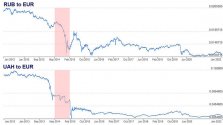Some more speculation on the nature of ongoing conflict in Ukraine based on historical evidence:
-----------------------
This is historical data on currency exchange rates from 2014-2015. It shows what effect the conflict had on main capital markets, especially Eurozone and USA.
War in Donbas begins in April of 2014 but the main escalation occurs in late August of 2014 when Russian forces directly intervene to stop Ukrainian counter-offensive and prevent collapse of separatist regions. The first ceasefire (Minsk I) occurs in September which is then broken in January of 2015 leading to second ceasefire (Minsk II) in February and the freezing of the conflict in current state.

From the beginning of war in Donbas in April 2014 to the ceasefire of Minsk II in February 2015 Euro has lost 25% of value ( from 1EUR=1,39USD to 1EUR=1,05USD). Such drop in value is caused by shifting of sufficient amount of capital from Euro-denominated markets and to USD-denominated markets. Since USD and EUR are two largest internationally traded currencies it means quite a substantial amount of capital that moved from Europe to USA.
This is not reflected in other currencies meaning that USD was the primary or even only beneficiary of the war in Ukraine.
British Pound rises in value only after Minsk II and it is a weaker shift than in USD. Reminder - this is over a year before the Brexit referendum in June 2016 and the impact can be seen easily on the graph.

Canadian Dollar and Yen register similar short-lived blips unlike a more stable USD shift in value reflecting long-term adjustment.

Both Ruble and Hryvna fall in value significantly by about 50% and 75% respectively.

Currently both American and British financial markets are separated from Euro which should provide them with a greater boost caused by capital flight.
In other words by stimulating the conflict in Ukraine the US caused a shift in capital from affected markets to US markets. Such process is essentially
plunder, just done with indirect means of market manipulation rather than with traditional methods.
It is expected that a similar withdrawal of capital from European markets would occur if the fighting in Ukraine was to resume and this is a secondary motive that the US and UK likely have in stimulating tensions and instability. While
everyone else stands to lose both economically and physically the US and UK stand to gain financially while bearing no physical losses.
-----------------------
Some information on military potential of Ukraine and Russia. Independent brigades and divisional regiments are treated equivalent units in terms of strength.
Belarussian forces consist of 4 mechanized brigades and 1 air assault brigade in total which is not sufficient to perform combat operations in Ukraine and guard the border with Poland, Lithuania and Latvia so they are excluded.
Ukraine
active forces:
- 2 tank brigades
- 12 mechanized brigades
- 4 motorized brigades
- 1 naval infantry brigade with potentially another almost ready
- 7 air assault brigades
- 3 mechanized (national guard) brigades
- 14 "public security" (national guard) brigades
- 8 security (national guard) regiments assigned to strategic locations (nuclear powerplants, industrial sites)
reserve forces - not mobilized currently:
- 3 reserve tank brigades
- 5 reserve mechanized brigades
- 25 brigades of light infantry/territorial defense (one per oblast)
Russia
- 10 airborne regiments
- 2 naval infantry brigades
- 6 tank brigades (regiment or brigade) in western military district
- 8 mechanized brigades in western military district
- 3 tank brigades in southern military district
- 6 mechanized brigades in southern military district
- 3 tank brigades in central military district
- 4 mechanized brigades in central military district
- up to 4 mechanized brigades in eastern military district
Those are the maximum extent of forces that can be used in Ukraine while retaining minimum defensive posture in all the other regions - all forces in Kaliningrad, near St.Petersburg, in Northern Military District and one brigade per army in Central and Eastern military districts. It means that to gather those units Russia is stripping its military districts of everything except the bare minimum.
Additionally the separatist regions have nominally fielded their own forces which are subordinate to the Russian Southern Military District
- 6 mechanized brigade equivalents in Donetsk
- 4 mechanized brigade equivalents in Luhansk
These units have combat strength below Ukrainian regular units but above Ukrainian national guard (except mechanized brigades) and territorial defense units.
Total minimum force
without mobilization of reserves available for combat operations at current moment:
Ukraine
- 2 tank brigades
- 16 mechanized brigades (incl. naval infantry)
- 11 motorized brigades (incl. air assault)
- 14 infantry/light brigades
Russia
- 12 tank brigades
- 20-24 mechanized brigades (incl. naval infantry)
- 10 motorized (airborne) regiments
- 10 allied (mechanized) brigades
While there is qualitative advantage on the Russian side both in terms of technology and experience Ukraine has sufficient strength to inflict high casualties against an invading forces. In particular Ukraine has 7 brigades of tube artillery and 4 brigades of rocket artillery compared to Russia's minimum available 6 brigades of artillery (tube and rocket) giving them at least parity. Artillery on brigade level is also comparable meaning that the necessary firepower exists as long as ammunition is provided. Stocks of ammunition for artillery are the crucial factor.
This does not look like Russia preparing an attack. It looks like Russia preparing for any eventuality and proactively restricting the movements for Washington. They stand to lose too much from a full-scale conflict even if it turns out in their favor. Any casualties and losses of equipment will be problematic as the units deployed are the primary fighting strength of Russian armed forces.
The US and UK stand to gain without almost any risk to their own position. Their only loss is not stimulation the conflict which makes them the obvious culprit for any instability and tensions taking place.
This is textbook example of the economic concept of "moral hazard".




